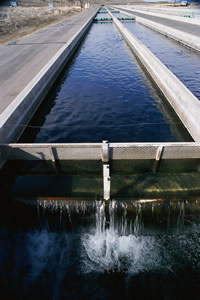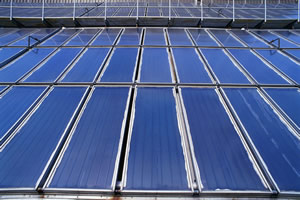Week 31 - Human Activities Affect Aquatic Environments
Lesson 12
Read pages 400 - 409
Lesson 12: Monitoring and Improving Water Quality
Since water is such an important part of our lives, we are concerned about the quantity and quality of our water supply. We have developed many ways of testing and improving our water quality using our abilities with technology. There are also some problems that we encounter with our water supply that we cannot solve using our current scientific and technological knowledge. 
 In this section, we are going to examine how we have learned to monitor and improve water quality. Then we will look at some challenges that remain for the water supply.
In this section, we are going to examine how we have learned to monitor and improve water quality. Then we will look at some challenges that remain for the water supply.Monitoring Water QualityOne widely used strategy, used to monitor the `health' of an ecosystem, is to monitor the health and numbers of one or more organisms that are particularly sensitive to the presence of pollutants or other environmental disturbances. Organisms that are used in this way are called `biological indicators.' An organism that is commonly used to monitor aquatic ecosystems is an alga species called Raphidocelis subcapitata. http://www.marietta.edu/~biol/introlab/ecosystem%20%20bioindicator%20lab.pdf . How do pesticides affect the environment?
When pesticides are used to control a target insect or weed species, beneficial insects and plants may also be adversely affected by direct contact with the pesticide. Pesticides can also harm beneficial organisms through a process called biomagnification . This refers to the increase in the concentration of a chemical in an organism over time, compared to the concentration of the chemical in the environment. Biomagnification occurs if a pesticide does not break down quickly. As insects, birds and animals eat contaminated food, the chemical accumulates in their bodies. With every step in the food chain, larger quantities of accumulated pesticide are eaten. This may continue to the point where these animals are adversely affected, or are unsafe for consumption. The Water Quality Tests
To gain more information about these tests visit google.
This next section was written by Mihir Gada Dissolved Oxygen This test is the most important of the nine water quality tests to measure water's ability to support plants and animals. There are many different factors that affect the amount of dissolved oxygen in water, the main one being temperature. As temperature rises, less gas will dissolve. Turbidity Turbidity measures water clarity, which allows sunlight to penetrate to a greater depth. The main sources of turbidity are erosion, living organisms, and those from human endeavors Total Solids Total solids measures both dissolved and suspended solids. There are six major types of total solids; silt, clay, soil runoff, plankton, industrial waste, and sewage. Ph Level The PH of water is important to aquatic life. If the PH falls below 4 or above 9 everything is dead. Temperature and Flow Rate Temperature is a very important part of a river's ecology. There are many natural and human factors that can affect a river's temperature. Human factors include industry, development, and dams. To measure temperature and flow rate you must find two places along the river that are about 1.6 kilometers apart that have the same conditions, then two people measure the temperature at approximately the same time. If the difference is greater than 2 degrees Celsius, then there is thermal pollution. To find flow rate you use a buoyant object, we used an orange, and float it down the river. Nitrates Nitrogen is necessary for plant and animal life. Water is tested for nitrates to monitor and control eutrofication , which causes more plant growth and decay. Fecal Coliform This nasty stuff is a certain bacteria that propagate in the digestive tracts of humans and animals. They coexist with other bacteria so they are often used as indicators of possible pathogenic contamination. There are many ways fecal coliform can enter a waterway such as animal waste, untreated sewage, combined sewage overflow, and septic tanks. Biochemical Oxygen Demand BOD is a measure of oxygen removed from an aquatic environment by aerobic microorganisms. It measures levels of organic pollution in lakes and streams. Phosphorous Phosphates is a nutrient needed in growth. The phosphate ion is found in shells, bones, and in animal teeth. By removing phosphorous from sewage the amount of phosphate ions in the water will be lowered. Exercise 4.2: Monitoring Water Quality
|
© 2002 Alberta Online Consortium
